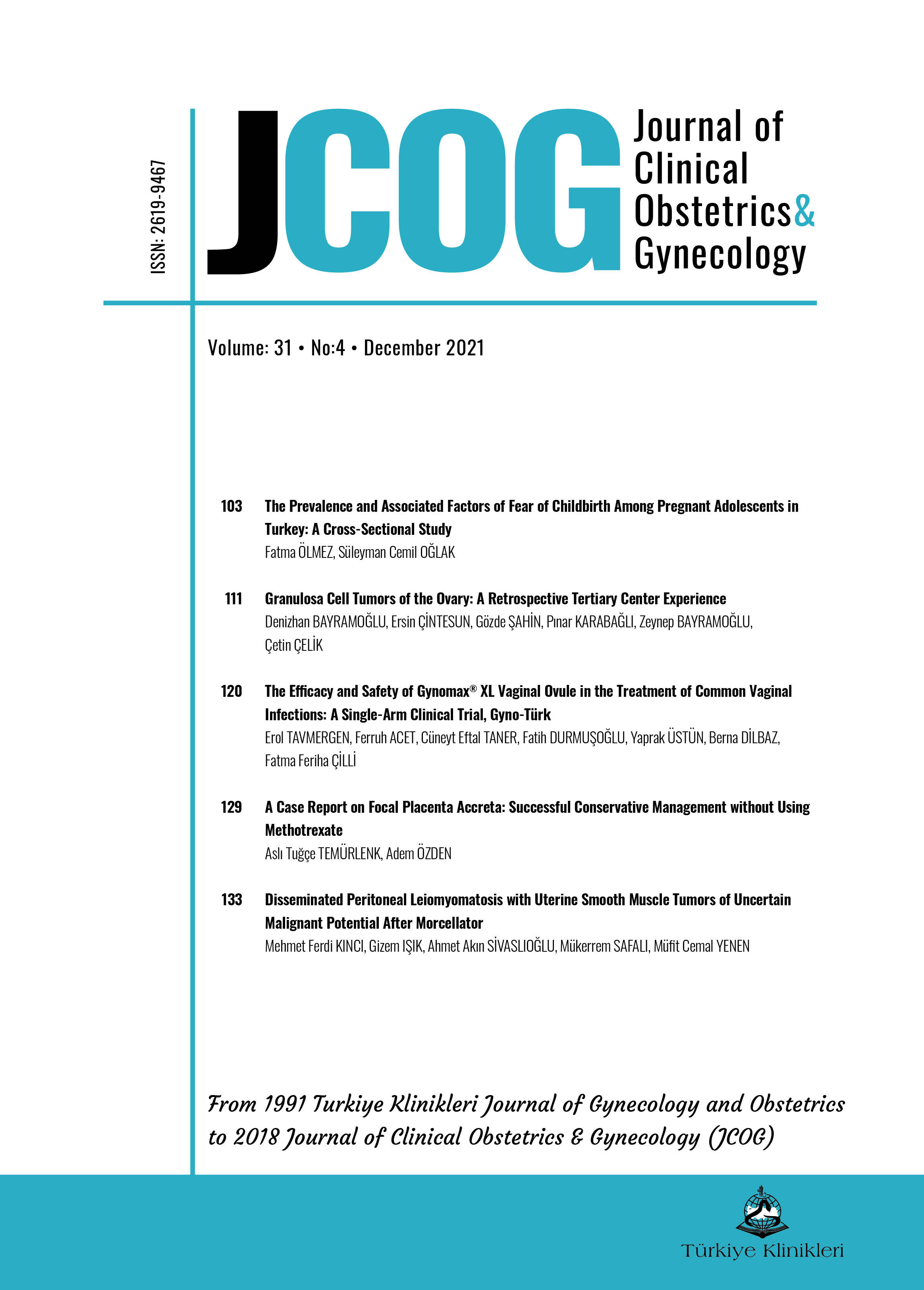Open Access
Peer Reviewed
CASE REPORTS
1956 Viewed1254 Downloaded
A Case Report on Focal Placenta Accreta: Successful Conservative Management without Using Methotrexate
Received: 26 Mar 2021 | Received in revised form: 06 Dec 2021
Accepted: 14 Dec 2021 | Available online: 16 Dec 2021
JCOG. 2021;31(4):129-32
DOI: 10.5336/jcog.2021-83353
Article Language: EN
Article Language: EN
Copyright Ⓒ 2025 by Türkiye Klinikleri. This is an open access article under the CC BY-NC-ND license (http://creativecommons.org/licenses/by-nc-nd/4.0/)
ABSTRACT
The incidence of the placenta accreta spectrum has gradually increased in recent years due to the increasing number of caesarean deliveries. Likewise, the technique of a conservative approach to these cases is more common. The conservative approach is known to reduce massive blood loss and the amount of hysterectomy performed. Our case was placenta previa-focal accreta, attached to the posterior wall and cervix. During caesarean section, though gently separating the placenta from the edges, invasive part of the placenta was left attached to the uterine wall. In this case, dealing with the retained invasive placental fragments, we aimed to avoid the side effects of methotrexate which has conflicting studies demonstrating the effect in the resorption of postpartum placental tissue. Four months after surgery, the remaining placental tissue was resected by operative hysteroscopy. This approach shows that placenta previa cases with focal accreta areas can be managed successfully by leaving the invasive part of the placental tissue.
The incidence of the placenta accreta spectrum has gradually increased in recent years due to the increasing number of caesarean deliveries. Likewise, the technique of a conservative approach to these cases is more common. The conservative approach is known to reduce massive blood loss and the amount of hysterectomy performed. Our case was placenta previa-focal accreta, attached to the posterior wall and cervix. During caesarean section, though gently separating the placenta from the edges, invasive part of the placenta was left attached to the uterine wall. In this case, dealing with the retained invasive placental fragments, we aimed to avoid the side effects of methotrexate which has conflicting studies demonstrating the effect in the resorption of postpartum placental tissue. Four months after surgery, the remaining placental tissue was resected by operative hysteroscopy. This approach shows that placenta previa cases with focal accreta areas can be managed successfully by leaving the invasive part of the placental tissue.
REFERENCES:
- Belfort MA, Shamshirsaz AA, Fox KA. The diagnosis and management of morbidly adherent placenta. Semin Perinatol. 2018;42(1): 49-58. [Crossref] [PubMed]
- Committee on Obstetric Practice. Committee opinion no. 529: placenta accreta. Obstet Gynecol. 2012;120(1):207-11. [Crossref] [PubMed]
- Silver RM, Landon MB, Rouse DJ, Leveno KJ, Spong CY, Thom EA, et al; National Institute of Child Health and Human Development Maternal-Fetal Medicine Units Network. Maternal morbidity associated with multiple repeat cesarean deliveries. Obstet Gynecol. 2006; 107(6):1226-32. [Crossref] [PubMed]
- Knight M; UKOSS. Peripartum hysterectomy in the UK: management and outcomes of the associated haemorrhage. BJOG. 2007; 114(11):1380-7. [Crossref] [PubMed]
- Doumouchtsis SK, Arulkumaran S. The morbidly adherent placenta: an overview of management options. Acta Obstet Gynecol Scand. 2010;89(9):1126-33. [Crossref] [PubMed]
- Yan H, Li Z, Yan Z, Li X, Li X, Yu L, et al. Methotrexate induces apoptosis of postpartum placental cytotrophoblasts. Cells Tissues Organs. 2017;203(4):231-42. [Crossref] [PubMed]
- Comstock CH, Love JJ Jr, Bronsteen RA, Lee W, Vettraino IM, Huang RR, et al. Sonographic detection of placenta accreta in the second and third trimesters of pregnancy. Am J Obstet Gynecol. 2004;190(4):1135-40. [Crossref] [PubMed]
- Warshak CR, Eskander R, Hull AD, Scioscia AL, Mattrey RF, Benirschke K, et al. Accuracy of ultrasonography and magnetic resonance imaging in the diagnosis of placenta accreta. Obstet Gynecol. 2006;108(3 Pt 1):573-81. [Crossref] [PubMed]
- Zhang C, Li H, Zuo C, Wang X. Retrospective analysis: Conservative treatment of placenta increta with methotrexate. J Obstet Gynaecol Res. 2018;44(5):907-13. [Crossref] [PubMed]
- Biele C, Kaufner L, Schwickert A, Nonnenmacher A, von Weizsäcker K, Muallem MZ, et al. Conservative management of abnormally invasive placenta complicated by local hyperfibrinolysis and beginning disseminated intravascular coagulation. Arch Gynecol Obstet. 2021;303(1):61-8. [Crossref] [PubMed] [PMC]
- Sentilhes L, Kayem G, Chandraharan E, Palacios-Jaraquemada J, Jauniaux E; FIGO Placenta Accreta Diagnosis and Management Expert Consensus Panel. FIGO consensus guidelines on placenta accreta spectrum disorders: Conservative management. Int J Gynaecol Obstet. 2018;140(3):291-8. [Crossref] [PubMed]
- Sentilhes L, Ambroselli C, Kayem G, Provansal M, Fernandez H, Perrotin F, et al. Maternal outcome after conservative treatment of placenta accreta. Obstet Gynecol. 2010;115(3):526-34. [Crossref] [PubMed]
- Morgan EA, Sidebottom A, Vacquier M, Wunderlich W, Loichinger M. The effect of placental location in cases of placenta accreta spectrum. Am J Obstet Gynecol. 2019;221(4): 357.e1-357.e5. [Crossref] [PubMed]
- Farasatinasab M, Moghaddas A, Dashti-Khadivaki S, Raoofi Z, Nasiripour S. Management of abnormal placenta implantation with methotrexate: a review of published data. Gynecol Obstet Invest. 2016;81(6):481-96. [Crossref] [PubMed]
- Fox KA, Shamshirsaz AA, Carusi D, Secord AA, Lee P, Turan OM, et al. Conservative management of morbidly adherent placenta: expert review. Am J Obstet Gynecol. 2015; 213(6):755-60. [Crossref] [PubMed]
MENU
POPULAR ARTICLES
MOST DOWNLOADED ARTICLES





This journal is licensed under a Creative Commons Attribution-NonCommercial-NoDerivatives 4.0 International License.










